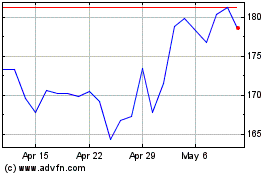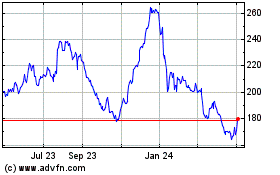By Jon Emont and Feliz Solomon
The Sriwijaya Air jet that crashed on Saturday didn't fly for
nearly nine months last year, with air travel severely reduced
because of the coronavirus pandemic, Indonesia's transportation
ministry said, as search crews pulled one of the plane's so-called
black boxes from the Java Sea.
The Boeing Co. 737-500 was inspected and declared airworthy
before resuming flying operations, the ministry said.
The Indonesian carrier's aircraft with 62 people on board went
down minutes after taking off from the country's capital, Jakarta.
There are believed to be no survivors.
Divers and search crew, who grappled with sharp debris and low
underwater visibility, managed to recover the plane's flight-data
recorder on Tuesday, an important early step in uncovering why
SJ182 crashed.
The plane had stopped operating in late March, weeks after
Indonesia announced its first Covid-19 case, the transportation
ministry said. The aircraft began flying again on Dec. 19, after
clearing an inspection by the ministry's Air Transportation
Directorate General, the ministry said.
The plane conducted a total of 132 flights after it resumed
flying, according to aviation data provider Flightradar24.
"This is pretty standard for this airline and this part of the
world," said Ian Petchenik, a Flightradar24 spokesman. "Because
aircraft are the main source of connectivity, there are a lot of
short routes with high frequencies."
Its first flight after the long hiatus didn't carry passengers
and was noncommercial, the ministry said. The first with passengers
was on Dec. 22, 2 1/2 weeks before the crash.
The aircraft's certificate of airworthiness from the transport
ministry is valid until Dec. 17, 2021, the transportation ministry
said.
The ministry said it followed an airworthiness directive issued
by the U.S. Federal Aviation Administration dated July 24 that
required operators of some Boeing flight models, including the
Boeing 737-500, to conduct an engine inspection before flying. On
Dec. 2, Indonesia's air inspector gave the plane an
engine-corrosion check.
Sriwijaya Air Chief Executive Jefferson Irwin Jauwena said
Tuesday that since March, Sriwijaya Air had undergone a security
and safety audit under the Basic Aviation Risk Standard program,
which is run by the Flight Safety Foundation in Alexandria, Va. The
audits look at several aspects, including safety- and
quality-system management, manual operations, licensing, and
supervision of aircraft and spare parts, he said.
A spokeswoman for Sriwijaya Air didn't immediately respond to
requests for comment on whether the plane's prolonged inactivity
might have affected its flightworthiness and what maintenance was
undertaken when the plane resumed flights in December. The airline
said earlier that the plane was in good condition before the
crash.
"It's important that the full records be made public, to show
where it was serviced, when and by whom," said Shukor Yusof,
founder of Malaysia-based aviation consulting firm Endau Analytics.
"I'm not questioning the reliability of these documents, but it
would be really good if we could see a full list, a full history of
this aircraft."
Some experts around the world have raised concerns that the
lower frequency of air travel during the pandemic could impact air
safety. Chow Kok Wah, a Singapore-based aviation consultant, said
planes that have been grounded for longer periods than usual
require unique inspection protocols. Investigators might look for
explanations in the aircraft's maintenance records, he said.
Answers about what happened to the aircraft may start to emerge
as investigators extract data from the recovered black box. The
flight-data recorder collects information about how plane systems
performed. The vast data it holds ranges from basic speed and
altitude figures to flight-control inputs by the crew.
"Hopefully it goes smoothly and we can reveal the mystery about
the cause of this accident," said Soerjanto Tjahjono, head of the
national transportation committee, after the device was
retrieved.
The recorder will be sent to a Jakarta laboratory run by the
country's national transportation safety committee, where
specialists will clean and dry it out before downloading the
information, which is stored in binary format. That process is
expected to take two to five days, followed by a deeper analysis of
the data.
Investigators often can assess what likely transpired on board
within a short period, though a detailed assessment typically takes
months.
Search crews will continue their underwater hunt for the second
black box -- the cockpit-voice recorder -- which captures pilot
conversations. That can help investigators understand what the
pilots were experiencing in the moments before the plane went down,
and connect the dots with what they glean from the flight-data
recorder. Both devices are important to help determine what caused
the crash.
Investigators haven't revealed the focus of their probe. Based
on a preliminary analysis, the head of the transportation safety
committee said the plane is unlikely to have exploded in the air
and instead likely broke apart when it crashed into the water at
high speed.
Authorities arrived at that conclusion because the shattered
aircraft's debris was contained in a limited area rather than
scattered over large areas of water, and based on an analysis of
radar signals.
Viriya Singgih contributed to this article.
Write to Jon Emont at jonathan.emont@wsj.com and Feliz Solomon
at feliz.solomon@wsj.com
(END) Dow Jones Newswires
January 12, 2021 11:19 ET (16:19 GMT)
Copyright (c) 2021 Dow Jones & Company, Inc.
Boeing (NYSE:BA)
Historical Stock Chart
From Mar 2024 to Apr 2024

Boeing (NYSE:BA)
Historical Stock Chart
From Apr 2023 to Apr 2024
